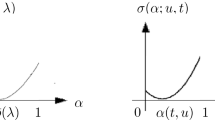Abstract
We consider a one-dimensional totally asymmetric exclusion model with quenched random jump rates associated with the particles, and an equivalent interface growth process on the square lattice. We obtain rigorous limit theorems for the shape of the interface, the motion of a tagged particle, and the macroscopic density profile on the hydrodynamic scale. The theorems are valid under almost every realization of the disordered rates. Under suitable conditions on the distribution of jump rates the model displays a disorder-dominated low-density phase where spatial inhomogeneities develop below the hydrodynamic resolution. The macroscopic signature of the phase transition is a density discontinuity at the front of the rarefaction wave moving out of an initial step-function profile. Numerical simulations of the density fluctuations ahead of the front suggest slow convergence to the predictions of a deterministic particle model on the real line, which contains only random velocities but no temporal noise.
Similar content being viewed by others
REFERENCES
M. Bardi and L. C. Evans, On Hopf's formulas for solutions of Hamilton-Jacobi equations, Nonlinear Anal. 8:1373–1381 (1984).
I. Benjamini, P. A. Ferrari, and C. Landim, Asymmetric conservative processes with random rates, Stochastic Process. Appl. 61:181–204 (1996).
E. Ben-Naim, P. Krapivsky, and S. Redner, Kinetics of clustering in traffic flows, Phys. Rev. E 50:822–829 (1994).
R. Durrett, Lecture Notes on Particle Systems and Percolation (Wadsworth and Brooks/Cole, 1988).
M. R. Evans, Bose-Einstein condensation in disordered exclusion models and relation to traffic flow, Europhys. Lett. 36:13–18 (1996).
M. R. Evans, Exact steady states of disordered hopping particle models with parallel and ordered sequential dynamics, J. Phys. A 30:5669–5685 (1997).
W. Feller, Introduction to Probability Theory and Its Applications, Vol. II (Wiley, New York, 1971).
P. W. Glynn and W. Whitt, Departures from many queues in series, Ann. Appl. Probab. 1:546–572 (1991).
D. Griffeath, Additive and Cancellative Interacting Particle Systems, Lecture Notes in Mathematics, Vol. 724 (Springer, Heidelberg, 1979).
T. Halpin-Healy and Y. C. Zhang, Kinetic roughening phenomena, stochastic growth, directed polymers and all that, Phys. Rep. 25:215–414 (1995).
F. Kelly, Reversibility and Stochastic Networks (John Wiley, 1979).
J. F. C. Kingman, The ergodic theory of subadditive stochastic processes, J. Royal Stat. Soc. Ser. B 30:499–510 (1968).
J. Krug, Platoon formations as a critical phenomenon, in Traffic and Granular Flow '97, D. E. Wolf and M. Schreckenberg, eds. (Springer, Singapore, 1998), p. 285.
J. Krug and P. A. Ferrari, Phase transitions in driven diffusive systems with random rates, J. Phys. A 29:L465–L471 (1998).
D. V. Ktitarev, D. Chowdhury, and D. E. Wolf, Stochastic traffic model with random deceleration probabilities: Queuing and power-law gap distribution, J. Phys. A 30:L221–L227 (1997).
P. Lax, Hyperbolic systems of conservation laws II, Comm. Pure Appl. Math. 10:537–566 (1957).
T. M. Liggett, Interacting Particle Systems (Springer-Verlag, New York, 1985).
P. L. Lions, Generalized Solutions of Hamilton-Jacobi Equations (Pitman, London, 1982).
M. Mézard, G. Parisi, and M. A. Virasoro, Spin Glass Theory and Beyond (World Scientific, Singapore, 1987).
K. Nagel, Life-times of simulated traffic jams, Int. J. Mod. Phys. C 5:567 (1994).
K. Nagel and M. Paczuski, Emergent traffic jams, Phys. Rev. E 51:2909 (1995).
C. Newman, Topics in Disordered Systems (Birkhäuser, Basel, 1997).
G. F. Newell, A theory of platoon formation in tunnel traffic, Oper. Res. 7:589–598 (1959).
R. T. Rockafellar, Convex Analysis (Princeton University Press, 1970).
H. Rost, Non-equilibrium behaviour of a many particle process: Density profile and local equilibrium, Z. Wahrsch. Verw. Gebiete 58:41–53 (1981).
S. Scheidl and V. M. Vinokur, Driven dynamics of periodic elastic media in disorder, Phys. Rev. E 57:2574–2593 (1998).
T. Seppäläinen, A scaling limit for queues in series, Ann. Appl. Probab. 7:855–872 (1997).
T. Seppäläinen, Hydrodynamic scaling, convex duality, and asymptotic shapes of growth models, Markov Process. Related Fields 4:1–26 (1998).
T. Seppäläinen, Coupling the totally asymmetric simple exclusion process with a moving interface, Markov Process. Related Fields 4:593–628 (1998). Proceedings of I Escola Brasileira de Probabilidade (IMPA, 1997).
T. Seppäläinen, Existence of hydrodynamics for the totally asymmetric simple K-exclusion process, Ann. Probab. 27:361–415 (1999).
Author information
Authors and Affiliations
Rights and permissions
About this article
Cite this article
Seppäläinen, T., Krug, J. Hydrodynamics and Platoon Formation for a Totally Asymmetric Exclusion Model with Particlewise Disorder. Journal of Statistical Physics 95, 525–567 (1999). https://doi.org/10.1023/A:1007535124155
Issue Date:
DOI: https://doi.org/10.1023/A:1007535124155




